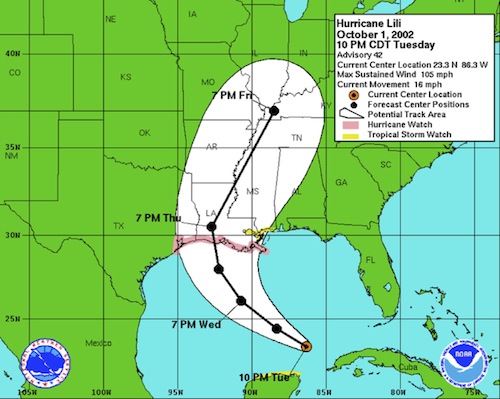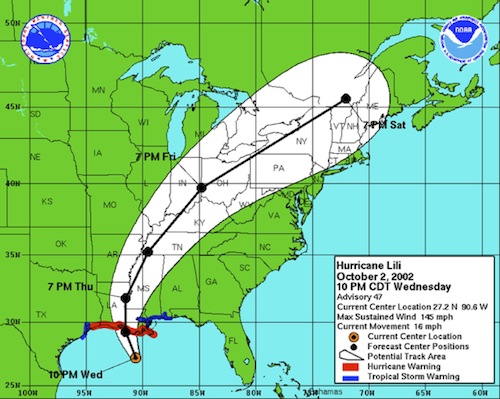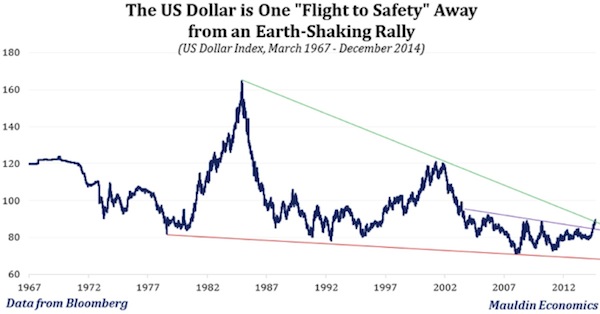Why the World Needs the US Economy to Struggle in 2015
Economics / US Economy Jan 05, 2015 - 12:52 PM GMTBy: John_Mauldin
 The headlines this morning talk about the US dollar hitting an 11-year high. I have been saying for years that the dollar is going to go higher than anyone can imagine. This trade is just in the early innings. And the repercussions will be dramatic, not only for emerging markets that have financed projects in dollars, but also for commodities and energy, gold, and a variety of other investments. The world is at the doorstep of a new era of volatility and currency wars.
The headlines this morning talk about the US dollar hitting an 11-year high. I have been saying for years that the dollar is going to go higher than anyone can imagine. This trade is just in the early innings. And the repercussions will be dramatic, not only for emerging markets that have financed projects in dollars, but also for commodities and energy, gold, and a variety of other investments. The world is at the doorstep of a new era of volatility and currency wars.
In this week’s letter, my associate Worth Wray explores what a rising dollar means for emerging markets and what central banks are likely to do in response. Can they smooth the ride, or will it be the world’s scariest roller coaster? This letter will print long because of the number of fabulous charts Worth provides. I might make a brief comment or two at the end. Here’s Worth.
On the Verge of a Disaster… or a Miracle
By Worth Wray
Twenty years after the first divergence-induced currency crisis of the 1990s, commodity prices are tumbling, the US dollar is rallying, and externally fragile emerging markets are reliving the horrors of their not-so-distant past. Except, this time, major economies like the United States, the United Kingdom, the Eurozone, Japan, and the People’s Republic of China may not be able to side-step the ensuing contagion.
With 2014 now behind us, I want to focus this week's letter on what may prove to be the most important global macro pressure points in the coming year(s):
- The growing divergence among the world’s most important central banks
- The ongoing collapse in oil and other commodity prices as a function of excess supply and/or weakening global demand
- The rise of the US dollar, driven by divergence and risk aversion… and the squeeze it’s putting on the multi-trillion-dollar carry trade into emerging markets
- The vicious slide in emerging-market currencies
- The rising risk of 1990s-style contagion and financial shocks
- And what, if anything, can avert the next global financial crisis
But first, let me tell you a story.
As some of you already know, I was born and raised in Baton Rouge, Louisiana – an old Southern city built on a bluff above the Mississippi River. It’s about an hour northwest of New Orleans – you can see it circled on the map below.
Given its inland position, Baton Rouge is fairly insulated from the fiercest impact of coastal storms; but hurricane season still tends to be the most stressful time of year. Our oak-covered neighborhoods and low-lying swamplands are vulnerable to the high winds and flood rains that can accompany a direct hit – not to mention the violent tornadoes that occasionally occur in the unpredictable northeastern quadrant of the tropical cyclone zone.
These storms don’t hit us often, but locals recall a handful of hurricanes that dealt heavy blows to the area over the years. And it goes without saying that the damage from any storm gets dramatically worse the closer you get to the Gulf of Mexico. Entire towns along the Gulf Coast have been swallowed up and swept away over the years by catastrophic storms like Camille (1969), Andrew (1994), and more recently Katrina (2005).
Twelve years ago, my father and I found ourselves in the path of such a storm.
According to the National Hurricane Center, Hurricane Lili was “supposed” to make landfall as a relatively weak storm. Just another named hurricane for the record books that would soon fade from our collective memory… or so we thought.
At 10:00 PM on Tuesday, October 1, 2002, Lili was a Category 2 hurricane with maximum sustained winds of 105 mph. Routine hurricane season stuff.

I went to sleep that night expecting a little rain and few uneventful days home from school; but when I woke up on Wednesday, October 2, I was shocked to see Lili develop an incredibly well-articulated eye wall and grow more powerful by the hour – from 110 mph at 7:00 AM that morning to 135 mph at 1:00 PM and finally to 145 mph at 10 PM that night.
I remember the nervous look on my dad’s face that night as the two of us boarded up our doors and windows. A little earlier that evening, one of his local government contacts shared that, behind closed doors, state and local officials were expecting “mass casualties” from Morgan City (on the coast) to Baton Rouge… but it was already too late to order an evacuation so far inland. Given the mild forecasts, few were prepared for a major hurricane; and at that point in the day, making a public announcement would do little more than spark a panic. The best we could do was hunker down and pray.
This was the last advisory I saw before my head hit the pillow that night: Lili had strengthened to a strong Category 4 hurricane with maximum sustained winds around 145 mph, reported gusts above 210 mph, and the very real possibility of making landfall as a merciless Category 5. If you look at the Saffir Simpson hurricane scale, there’s a reason the first word you see next to Category 4 and 5 storms is catastrophic. These storms are real killers.

Expecting to wake up early the next morning to sounds of thunder, pounding rain, and the eerie whistle of gale-force winds – or worse, I went to sleep Wednesday night with this image swirling through my mind:
But when I woke, I was shocked once more to learn that Lili – for reasons no one had anticipated – had all but died in the night and made landfall that morning as a small Category 1 hurricane with maximum sustained winds of only 90 miles per hour. In less than twelve hours, it had sharply decelerated from what could easily have been one of the most catastrophic storms on record to an inconvenience for most inland communities. Sure, it inflicted some damage along the coast – tearing up marshlands, knocking down power lines, blowing over trees, and flooding homes – but a Category 4 or 5 storm would have swallowed those areas whole.
As far as I know, there was no precedent in the Gulf of Mexico – or anywhere in the world – for Lili’s sudden death. It baffled even the most experienced meteorologists and left us all scratching our heads. Some people talked of miracles; others insisted there had to be a logical explanation. I imagine there’s some truth to both ideas.
While the press coverage surrounding Lili’s remarkable weakening has largely faded into obscurity, I was able to find one surviving article from USA Today that captures the confusion in the storm’s aftermath: “Scientists Don’t Know Yet Why Lili Suddenly Collapsed.”
Hurricane Lili showed forecasters there is still a lot they don't know about hurricane intensity. Lili weakened in the hours before landfall Thursday as rapidly as it had strengthened into a ferocious storm the day before. Forecasters with the National Hurricane Center in Miami had hinted as early as Monday that Lili could rev up into a dangerous hurricane over the extraordinarily warm Gulf of Mexico, though they were surprised to see it grow so strong so quickly. But Lili's quick demise … had them admitting they didn't know what had happened…. National Hurricane Center Director Max Mayfield agrees. At a loss to explain Lili's fluctuations, he says, “A lot of Ph.D.s will be written about this.”
We still don’t have a definitive answer, but three theories emerged in the immediate aftermath:
1) Dry air was pulled into the storm and ate away at its moisture-sucking core;
2) Winds aloft increased across the storm, creating wind shear and tipping the delicate balance that keeps intense storms going;
3) Water cooler than the 80° necessary to sustain a hurricane sapped Lili's strength when it moved over the same part of the north-central Gulf of Mexico that had been churned up by a smaller hurricane, Isadore, a week earlier.
Regardless of why it happened, I learned something that day that will stay with me for the rest of my life: Even when a disastrous course of events is set in motion, disaster does not always strike. Surprises happen. Even miracles. Forecasts are often wrong – but it always pays to prepare.
Let me explain…
Just before Halloween, I wrote a letter (“A Scary Story for Emerging Markets”) explaining that the widening gap in economic activity among the United States, Japan, and the Eurozone was starting to demand a dangerous divergence in monetary policy.
Within a matter of days, the FOMC announced the end of its QE3 program... and then the Bank of Japan shocked the world, announcing a massive expansion in its own asset purchases timed to coincide with the government pension fund’s announcement that it was getting out of JGBs and into global equities.

Just as I had feared, the US dollar and Japanese yen were breaking out in opposite directions on real policy action, as Mario Draghi meanwhile continued to talk the euro down with the threat of future action. This may seem like a trivial shift in global FX markets, but it may have been the most important development we have seen since the global crisis peaked in 2008.

Since then, global economics has been a story of boom, gloom, and doom, as Marc Faber likes to say. We’re seeing a boom in US economic activity (or as much of a boom as you can expect with a massive debt overhang); a gloomy slowdown and slide toward deflation across Europe and China, along with the still-likely failure of Abenomics in Japan and renewed signs of FX contagion in emerging markets; and doom in commodities markets, particularly oil.
I’ve shared this next chart before, but it’s worth an update. Those of us who watch the US dollar were not surprised by the collapse in oil prices, because the dollar’s surge was already telling us something about global demand.

What did surprise a lot of economists (myself included) was the breakdown within OPEC, particularly Saudi Arabia’s willingness to accept whatever price the market offered in order to protect its market share. Conspiracy theories aside as to whether OPEC’s move constitutes an anti-American trade war against US shale producers or a pro-American squeeze on Russia, Iran, and Venezuela, it’s already putting a serious squeeze on Texas oil men, Russian “oiligarchs,” and oil-exporting emerging markets.
We’ll revisit the oil shock in a bit, but for now let’s get back to the US dollar

To continue reading this article from Thoughts from the Frontline – a free weekly publication by John Mauldin, renowned financial expert, best-selling author, and Chairman of Mauldin Economics – please click here.
John Mauldin Archive |
© 2005-2022 http://www.MarketOracle.co.uk - The Market Oracle is a FREE Daily Financial Markets Analysis & Forecasting online publication.



